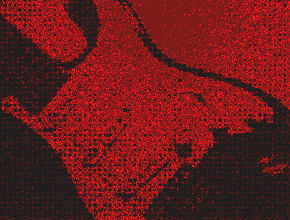Note: This is part of a series commemorating the 25-year anniversary of the band Meshuggah by exploring the roots and legacy of Meshuggah’s style of progressive metal rhythm.
Meshuggah’s unique rhythmic style is instantly identifiable, and it is easy to hear their influence in a number of recent bands. A number of Meshuggah’s imitators have been clustered together by fans and critics under the genre label “Djent.” This name supposedly refers to the staple sound of the style, a palm-muted power chord played with heavy distortion on the lower strings of a 7- or 8-string guitar. One of the more successful bands in this style is Tesseract, who layer the Meshuggah-influenced Djent sound with clean vocals, soaring choruses, and softer acoustic sections. A representative example of their style is the song “Retrospect” from their second studio album Altered State (2013).
Not everyone is a fan of Tesseract’s smooth production and more melodic approach. Encyclopedia Metallum, the indispensable resource for all things metal, explicitly bans Tesseract from its website in their rules page.
First and foremost, for a band to be metal, it must have metal riffs. This point should be fairly straight-forward and obvious. Nevertheless, when it comes to some genres or styles, it’s not always implied that the music is rooted in metal or is substantively comprised of metal riffs. For example, grindcore can either be rooted in punk (ex. Anal Cunt) or in death metal (ex. Nasum, Pig Destroyer, Agathocles); metalcore rooted in hardcore/-core (ex. Atreyu) or in metal (ex. The Red Chord); and so on. Such music can be borderline, but still be acceptable. Some bands have mostly chugging, fuzz, or noodling, with minor metal influences; this does not make these bands metal. The metal elements must outweigh the non-metal ones.
[…]
We do NOT accept the following (this is our decision, please don’t argue this):
[…]
Djent (ex: Animals as Leaders, Periphery, TesseracT)
While they have plenty of non-metal sounds, some elements of Tesseract’s style are directly out of Meshuggah’s playbook. The main riff for “Retrospect” looks a lot like a Meshuggah riff, with a repeating syncopated fragment that has slightly different endings every time. ((Jonathan Pieslak’s article about Meshuggah’s earlier albums is probably the most extensive description of their style in print.
Pieslak, Jonathan. “Re-casting Metal: Rhythm and Meter in the Music of Meshuggah.” Music Theory Spectrum Vol. 29, No. 2 (2007): pp. 219-245.))
The last appearance of the main riff is the “mosh section,” which starts at 3:26. For any readers that don’t already know, moshing is a kind of dancing that involves deliberately colliding with other participants, and it is popular among some metal and punk audiences. Fans call particular sections of a song “mosh parts” or “breakdowns” when they have certain characteristics that give these sections especially intense physical energy. Mosh sections usually feature a unison riff that has a very distinct rhythm, often set to only a couple of different pitches. Frequently, breakdown riffs have a really sharp syncopation or other off-beat rhythm. Mosh sections usually have a slow, heavy feel, emphasized by the band’s unison rhythm and a maximum amount of distortion. Another essential part of this convention is a continuous stream of quarter notes on a cymbal, frequently something especially bright or harsh one like a china crash.
As in many of the heavier sections in Meshuggah’s music, the drummer hits the snare along with the third quarter note in the measure, creating a kind of half-time back beat that stubbornly refuses to conform to the rhythm of the guitars. The guitar rhythm is mostly doubled by the bass drum. These two layers of rhythm never seem to line up the same way twice, giving the music a feeling of disjointedness that is characterizes much of Meshuggah’s music. Meshuggah tends to use patterns with slightly more variety in durations — this riff uses a lot of dotted eighth-notes in a row. Otherwise, the guitar and drum parts in the breakdown have few differences from Meshuggah’s style.
Although the editors of Encyclopedia Metallum will disqualify Tesseract as a metal band for the clean vocals that are sung over this breakdown, the rhythmic effect of the section is very similar to Meshuggah’s music. I myself feel like Tesseract belongs in the metal camp. Sure, they have plenty of qualities that don’t sound like metal. But as a whole their style sounds more like metal than it sounds like any other genre I listen to. One thing is certain: Tesseract sounds nothing like the progressive metal or extreme metal of the 1990s. Meshuggah’s musical legacy has clearly has had an influence far beyond the scene in which they originated.



Excellent transcription! I’ve been down with TesseracT since the days of MySpace. It’s good to see someone write up a theoretical explanation. Keep up the good work!